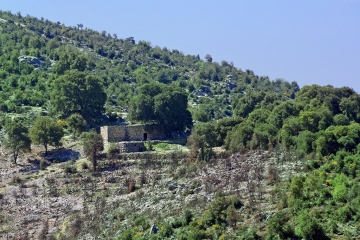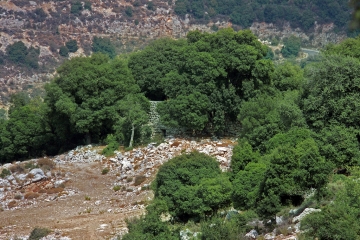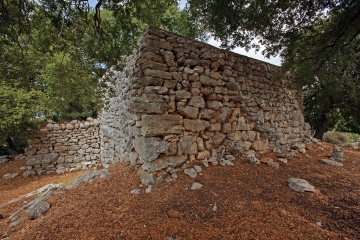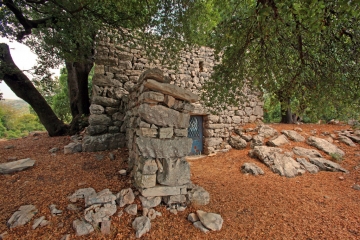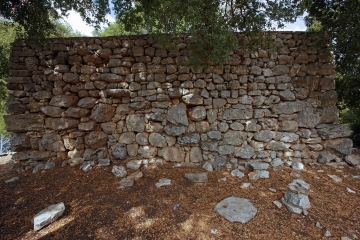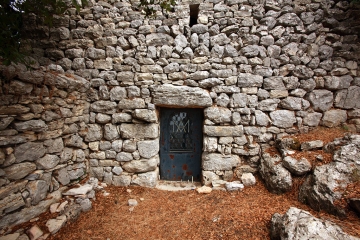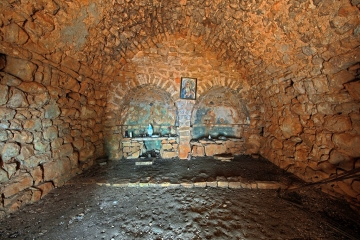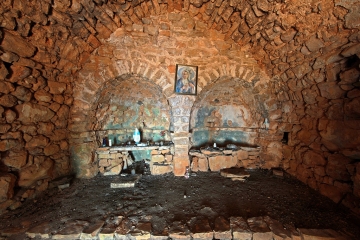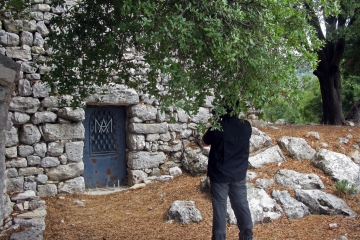دير سيّدة - هابيل
هابيل قرية تَقَع في ناحية جبيل، ولاسمها هذا عِبري، ويعني إبن آدم الثاني. أمّا القدماء من أهل هابيل فيردّون الاسم إلى مقطعين: Habو il ومَعناهما "خوف الله". ودير السيّدة فيها يقوم على تلَّة تشرف على القرية من جِهتها الغربية وتُسمّى "قرنة عَرمتى"، وهي تعلو عن سطح البحر 950 متراً.
النواويس العديدة التي وُجدت في القرية محفورةً في الصخر.. مِمّا يَدِلُّ على أنها سُكنت منذ القِدَم، كما سُكنت أيضاً في العصور الوسطى بعد أن بُني فيها المقرّ البطريركيّ.
وكنيسة هذا الدير هي عِبارة عن بناءٍ مُستطيل مُشَيَّد من حَجَر الدِبّاشي، وذو مَدخلٍ واحدٍ واطىء يقوم في جهتها الغربية. وفي الجهة الشمالية من هذا المَدخل تظهر بقايا الرواق المقبَّب الذي كان يُغطّي المسافة أمامه، كما جاء في كتاب الدكتور كريستيان الخوري "العذراء مريم في لبنان"، مُضيفاً أن في الكنيسة صورة لمريم القلب الأقدس، وفوق كل مذبح من مذابحها تمثال صغير للسيّدة العذراء. وفي جوار الكنيسة يقوم المقرّ البطريركي، وإضافةً إليه توجَد خرائب عِدَّة يعتبرها أهل المنطقة جزءاً من هذا المقرّ، وقد طال الزمن عليها وهي مُهمَلة لم تَمتَدّ اليد إليها حتى العام 2012، حيث جَرى تَرميم الكنيسة من الداخل والخارج، ما عدا الخرائب والأقبية المُحيطة، التي بقيت فريسة الإهمال.
وفي رسالةٍ لإبن القلاعي إن هذا الدير ظلَّ كرسيّاً بطريركياً مارونياً إلى زَمَن البطريرك إرميا، وهذا ما تذكره أيضاً التواريخ القديمة. ولكنه يورد في رسالته أنه لم يستطع اللإهتداء إلى أسماء البطاركة الذين أقاموا في هذا الدير، ويعني بهم جميع البطاركة الذين سَكنوه ما بين البطريرك يوحنا اللحفدي والبطريرك إرميا العمشيتي.
ومثل إبن القلاعي، كان أيضاً البطريرك اسطفان الدويهي في سِلسِلته للبطاركة، إذ يعترف بأنه مع ما بُذل من التنقيب والبحث لم يتمكن من الوصول إلى اسماء جميع البطاركة الذين أقاموا في دير سيّدة هابيل ما بين البطريركين المذكورَين. يبقى أن السمعاني ذكر أن هناك ثلاثة من البطاركة يدعى كل منهم "بطرس" أقاموا في هذا الدير في الحقبة الزمنية المارّ ذكرها.
وقد رجعنا إلى "دائرة المعارف" اللبنانية لنرى اذا كانت تلقي ضوءاً على ذلك في فصلها عن البطريرك إرميا العمشيتي، فوجدنا فيها ان البطريرك بطرس توفي في دير سيّدة هابيل سنة 1209 على ما في "تاريخ الازمنة" للدويهي، او سنة 1199 على ما في غيره من المراجع، فاجتمع الأساقفة وأعيان الشعب في دير إيليج في ميفوق وانتخبوا إرميا بطريركاً. والمُلفت للنظر أن الدويهي يقول في "سلسلة البطاركة" إنه لم يهتدِ إلى مَعرِفة أيّ ٍ من البطاركة الذين مرّوا في هذا الدير ما بين اللحفدي والعمشيتي، ثم يُسمّي في "تاريخ الازمنة" البطريرك بطرس مُحدِّداً تاريخ وفاته في العام 1209!
وتعود بداية بناء هذا الدير إلى أيام البطريرك يوحنا اللحفدي (1151-1154) الذي نقل كرسيّه من إيليج إلى قريته لِحفد، ثم إنتقل إلى هابيل حيث أقام فيها ديراً.
والسمعاني كان دقيقاً في ذِكرِه بطريركين من الثلاثة الذين أورد سكناهم في دير سيّدة هابيل ما بين البطريركين اللحفدي والعَمشيتي، إذ يقول إن سني البطريرك بطرس الثاني كانت ما بين 1154 و1173، وإن هذا البطريرك تابع بناء الدير، مُقيماً في دير سيّدة إيليج حتى تَمام تشييد دير هابيل. كما يذكر أن البطريرك بطرس الثالث خَلَفَ بطرس الثاني وإمتدَّت سنو بطريركيته من العام 1173 إلى 1199، إلا إن اللائحة التي مَرَّ ذكرها حول أسماء البطاركة الموارنة الذين تعاقبوا خلال الحقبة الصليبية (1099-1305) تُحدِّد سني ولاية هذا البطريرك ما بين 1173 و 1189. ويقول السمعاني إن هذا البطريرك، بطرس الثالث، تنقَّل مثل سلفه بطرس الثاني ما بين إيليج وهابيل.
والكاتب فيكتور صوما، في مؤلَّف له بالفرنسية عنوانه "لبنان على خُطوة صغيرةٍ " (ص 255)، يقول ان آخر مَن مرَّ من البطاركة في دير سيّدة هابيل كان البطريرك داود الجاجي المُكنّى بيوحنّا، وذلك قبل انتقاله إلى دير مار سركيس القرن في أرض حردين.
The Monastery of Our Lady of Habil
Habil is a village located in the district of Byblos, and its name is Hebrew, and it means the second son of Adam. As for the elders of Habil, they divide the name into two syllables: Hab and il, meaning “the fear of God.” Our Lady’s Monastery is located on a hill overlooking the village from its western side, and it is called “Qornet Armati”, which is 950 meters above sea level. The many sarcophagi that were found in the village were engraved in the rock, which indicates that it was inhabited since antiquity, as well as in the Middle Ages after the patriarchal headquarters was built in it
The church of this monastery is a rectangular building built of Dabbashi stone, with one low entrance on its western side. On the northern side of this entrance, the remains of the vaulted portico that covered the space in front of it appear, as stated in Dr. Christian El Khoury’s book “The Virgin Mary in Lebanon”. He adds that in the church there is a picture of Mary the Sacred Heart, and above each of its altars is a small statue of the Virgin. In the vicinity of the church, there is a building made of the Dabbashi stone. It is said that it is part of the patriarchal headquarters. Its floor is not paved, and in addition, there are several ruins and brick buildings that the people of the region consider part of this headquarters. The compound was neglected for a long time and wasn’t restored until 2012, when the church was restored from the inside and outside
Not far from it are cellars that still exist and are also the victims of neglect. Ibn al-Qala'I wrote that this monastery remained a Maronite patriarchal seat until the time of Patriarch Jeremiah, as ancient history also mentions. But he states in his writings that he could not find the names of the patriarchs who resided in this monastery, i.e., all the patriarchs who inhabited it between Patriarch Youhanna al-Lehfedi and Patriarch Jeremiah al-Amshiti. Patriarch Estephan al-Doueihy also admits that throughout his research, he was unable to find the names of all the patriarchs who resided in the monastery of Our Lady of Abel between the two mentioned patriarchs
Al-Samani, however, mentioned that there were three patriarchs, each called “Boutros,” who resided in this monastery during the aforementioned era. We went back to the Lebanese “Encyclopedia of Knowledge” to see if it sheds light on this in its chapter on Patriarch Jeremiah al-Amshiti. We found in it that Patriarch Boutros died in the monastery of Our Lady of Habil in 1209, according to Doueihy’s “History of Time”, but that some documents place his death in 1199. The bishops and notables of the people then gathered in the Elige monastery in Mayfouq and elected Jeremiah as patriarch. What is striking is that Al-Doueihy says in “The History of Patriarchs” that he couldn’t find information on any of the patriarchs who passed through this monastery between al-Lahfadi and al-Amshiti, and then named in “The History of Time” Patriarch Boutros, placing his death in 1209. The beginning of the construction of this monastery dates back to the days of Patriarch Youhanna al-Lehfedi (1151-1154), who moved his seat from Mayfouq to his village of Lehfed, then moved to Habil, where he established a monastery
Al-Samani accurately mentioned that, other than the Patriarchs al-Lehfedi and al-Amshiti, Patriarch Boutros II continued the construction of the monastery, residing in the monastery of Our Lady of Elige until the completion of the construction of the monastery of Habil. He also mentioned that Patriarch Peter III succeeded Peter II and that his patriarchate extended from the year 1173 to 1199, but the list of the names of the Maronite patriarchs who during the Crusader era (1099-1305) specifies the years of this patriarch’s tenure between 1173 and 1189. Al-Samani added that, like his predecessor Boutros II, Boutros III moved constantly between Mayfouq and Habil. And the writer Victor Sawma, in one of his books, says that the last patriarch to pass through the monastery of Our Lady of Habil was Patriarch Daoud al-Jaji, nicknamed Youhanna, before he moved to the monastery of Mar Sarkis al-Qarn in Hardin.
